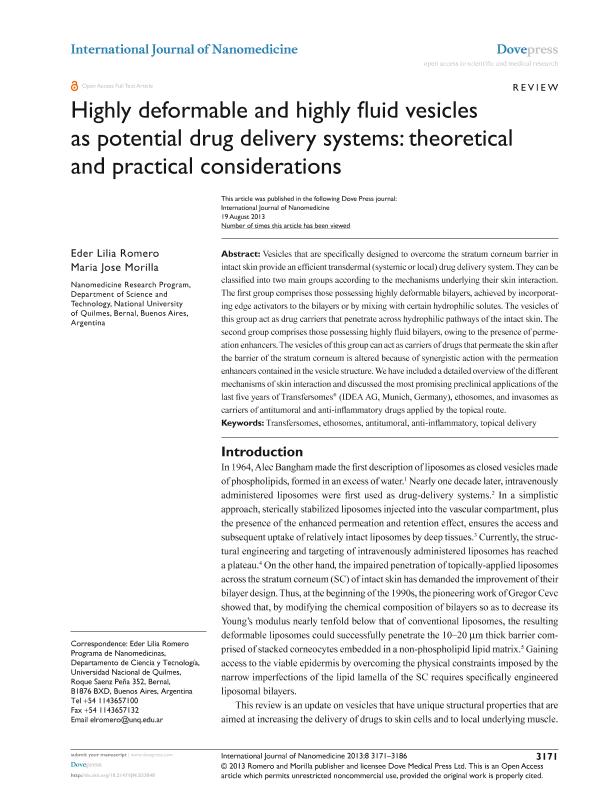Mostrar el registro sencillo del ítem
dc.contributor.author
Romero, Eder Lilia

dc.contributor.author
Morilla, María José

dc.date.available
2017-09-07T18:40:23Z
dc.date.issued
2013-06
dc.identifier.citation
Romero, Eder Lilia; Morilla, María José; Highly deformable and highly fluid vesicles as potential drug delivery systems: theoretical and practical considerations; Dove Press; International Journal of Nanomedicine; 8; 1; 6-2013; 3171-3186
dc.identifier.issn
1176-9114
dc.identifier.uri
http://hdl.handle.net/11336/23790
dc.description.abstract
Vesicles that are specifically designed to overcome the stratum corneum barrier in intact skin provide an efficient transdermal (systemic or local) drug delivery system. They can be classified into two main groups according to the mechanisms underlying their skin interaction. The first group comprises those possessing highly deformable bilayers, achieved by incorporating edge activators to the bilayers or by mixing with certain hydrophilic solutes. The vesicles of this group act as drug carriers that penetrate across hydrophilic pathways of the intact skin. The second group comprises those possessing highly fluid bilayers, owing to the presence of permeation enhancers. The vesicles of this group can act as carriers of drugs that permeate the skin after the barrier of the stratum corneum is altered because of synergistic action with the permeation enhancers contained in the vesicle structure. We have included a detailed overview of the different mechanisms of skin interaction and discussed the most promising preclinical applications of the last five years of Transfersomes® (IDEA AG, Munich, Germany), ethosomes, and invasomes as carriers of antitumoral and anti-inflammatory drugs applied by the topical route.
dc.format
application/pdf
dc.language.iso
eng
dc.publisher
Dove Press

dc.rights
info:eu-repo/semantics/openAccess
dc.rights.uri
https://creativecommons.org/licenses/by-nc/2.5/ar/
dc.subject
Transfersomes
dc.subject
Ethosomes
dc.subject
Antitumoral
dc.subject
Anti-Inflammatory
dc.subject.classification
Nano-materiales

dc.subject.classification
Nanotecnología

dc.subject.classification
INGENIERÍAS Y TECNOLOGÍAS

dc.title
Highly deformable and highly fluid vesicles as potential drug delivery systems: theoretical and practical considerations
dc.type
info:eu-repo/semantics/article
dc.type
info:ar-repo/semantics/artículo
dc.type
info:eu-repo/semantics/publishedVersion
dc.date.updated
2017-09-07T16:56:32Z
dc.identifier.eissn
1178-2013
dc.journal.volume
8
dc.journal.number
1
dc.journal.pagination
3171-3186
dc.journal.pais
Reino Unido

dc.journal.ciudad
Londres
dc.description.fil
Fil: Romero, Eder Lilia. Universidad Nacional de Quilmes. Departamento de Ciencia y Tecnología; Argentina. Consejo Nacional de Investigaciones Científicas y Técnicas; Argentina
dc.description.fil
Fil: Morilla, María José. Universidad Nacional de Quilmes. Departamento de Ciencia y Tecnología; Argentina. Consejo Nacional de Investigaciones Científicas y Técnicas; Argentina
dc.journal.title
International Journal of Nanomedicine

dc.relation.alternativeid
info:eu-repo/semantics/altIdentifier/url/https://www.dovepress.com/highly-deformable-and-highly-fluid-vesicles-as-potential-drug-delivery-peer-reviewed-article-IJN
dc.relation.alternativeid
info:eu-repo/semantics/altIdentifier/doi/http://dx.doi.org/10.2147/IJN.S33048
dc.relation.alternativeid
info:eu-repo/semantics/altIdentifier/url/https://www.ncbi.nlm.nih.gov/pmc/articles/PMC3754763/
Archivos asociados
